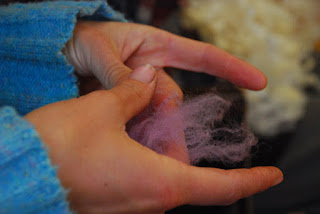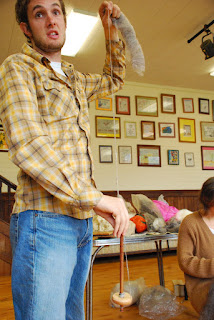Through a grant from the Humboldt Area Foundation, about 15 of us were able to take this two-day workshop free! Snacks and childcare were provided, and Michael hand made each of us our very own hardwood drop spindle. What a fabulous way to spend a weekend.
First, we learned how to take the raw, washed wool, and separate out the fibers, and orient the strands all the same way. After meticulously making a downy pile of this material, we seated it on the cards, and carded it until it was straight and combed. Then, we rolled it off the cards, creating a fluffy tube. Many of us commented on how tedious this task was, but when no one was complaining about that, we had delightful conversations about all manner of things sheep, wool, and yarn. It was something like a knitting circle, a cultural phenomenon that must have been a staple of community relationships in times past.

Raw Washed Wool Ready for Carding

Separating and Orienting the Fibers

Seating the Fibers on the Cards

Carding the Wool
After we collected a pile of the fluffy tubes, we each chose our spindle, and Michael at last demonstrated the proper technique for spinning a yarn with the drop spindle. Using a little tail of already spun yarn, you wrap it around the "bobbin" at the bottom of the spindle, and then loop it around the top. Then you can spin the spindle clockwise, and pinch, draft, let go, allow to twist, pinch, and so on, and out stretches your first attempt at yarn, lumpy, uneven, but so very satisfying. After about 5 feet of length, you must untie the part on the spindle, wind up your newly made yarn, and repeat.

Spindles

Fluffy Tubes of Carded Wool Ready for Spinning

Setting Up the Spindles for Spinning

Michael Demonstrating Spinning Technique
Michael sent us home overnight with raw wool, cards, and of course, our new spindles. I practiced a little, and by mid-way through this morning's session, I was getting a little faster at it. What fun! At this point, Michael demonstrated the use of the spinning wheels, which I was very excited to try, but found a lot harder to master even basic technique. It requires a bit of coordination, between your feet which are operating the wheel, and your hands, which are doing the pinch, draft, release, pinch repetition, all the while maintaining the proper tension to allow the resulting yarn to wind on a spool. I can see that this task will require at least a bit more practice.

Michael Demonstrates Use of the Spinning Wheel

Jane Gives it a Try
It's a little disconcerting to feel so helpless at a task that was very common and required all but maybe 100 years ago, give or take a few years. What was so exciting was the buzz amongst the community of new spinners, our desire to learn the craft, and to figure out the local supply chain. Plans were made for regular spinning gatherings, and also for a dyeing workshop. I think that we are all a little needy of the community craft culture, the conversations and group thinking that happens when people gather around a task that occupies the hands, but keeps the mind free to wander. I imagine this is where the expression "spinning a yarn" comes from, the stories people would tell while spinning fiber to clothe their bodies.
No comments:
Post a Comment